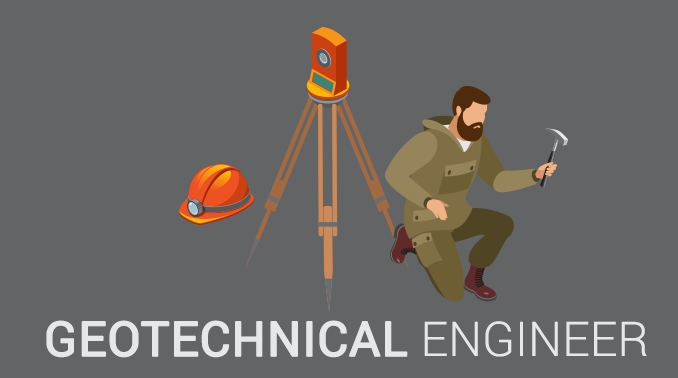9 Easy Facts About Geotheta Shown
9 Easy Facts About Geotheta Shown
Blog Article
The Best Strategy To Use For Geotheta
Table of ContentsAn Unbiased View of GeothetaThe Greatest Guide To GeothetaWhat Does Geotheta Do?About GeothetaSome Known Details About Geotheta

They conduct site investigations, collect samples, do research laboratory examinations, and analyze data to assess the suitability of the ground for building jobs - Consulting Engineer. Based upon their searchings for, geotechnical designers give referrals for structure layout, slope security, retaining structures, and reduction of geotechnical threats. They team up with various other specialists, such as engineers, architectural engineers, and construction teams, to make certain that geotechnical factors to consider are incorporated into the overall project layout and execution
By examining the habits and buildings of dirt and rock, they can determine potential geotechnical threats such as landslides, dirt settlement, or incline instability. Their proficiency aids stop failures or mishaps that could endanger lives and residential or commercial property. Here are some thorough tasks and obligations of a geotechnical designer: Website Examination: Geotechnical engineers conduct website examinations to gather information on subsurface conditions.
They translate the data to comprehend the residential properties and habits of the soil and rock, including their strength, leaks in the structure, compaction features, and groundwater problems. Geotechnical Analysis and Design: Geotechnical engineers evaluate the data gathered during website investigations to evaluate the stability and viability of the site for building projects. They execute geotechnical estimations and modeling to review aspects such as bearing capacity, negotiation, slope security, lateral planet pressures, and groundwater flow.
The Only Guide for Geotheta
Structure Design: Geotechnical designers play a vital duty in creating structures that can safely sustain the intended framework. They assess the dirt problems and load demands to determine the proper foundation type, such as superficial foundations (e.g., footings), deep structures (e.g (https://geotheta.carrd.co/)., stacks), or specialized techniques like soil renovation. They consider aspects such as settlement limitations, birthing ability, and soil-structure interaction to develop optimum foundation layouts
They evaluate building and construction strategies, monitor site tasks, and carry out field examinations to confirm that the design recommendations are followed. If unpredicted geotechnical concerns develop, they assess the scenario and offer referrals for remediation or changes to the design. Threat Evaluation and Reduction: Geotechnical designers analyze geotechnical dangers and risks connected with the task website, such as landslides, liquefaction, or dirt erosion.

Cooperation and Interaction: Geotechnical engineers function closely with various other experts associated with a task, such as designers, architectural engineers, and building groups. Effective communication and cooperation are important to integrate geotechnical considerations into the total task design and building procedure. Geotechnical designers provide technical competence, solution questions, and make certain that geotechnical needs are satisfied.
The smart Trick of Geotheta That Nobody is Discussing
Below are some kinds of geotechnical designers: Foundation Designer: Foundation designers concentrate on developing and analyzing foundations for frameworks. They assess the dirt conditions, tons demands, and site attributes to identify the most ideal foundation kind and design, such as superficial structures, deep structures, or specialized strategies like pile structures.
They review the factors influencing incline stability, such as soil homes, groundwater conditions, and slope geometry, and develop strategies to stop slope failures and reduce threats. Earthquake Designer: Quake designers focus on assessing and designing frameworks to endure seismic pressures. They evaluate the seismic hazard of a site, assess dirt liquefaction capacity, and establish seismic style standards to make certain the safety and security and strength of structures throughout quakes.
They perform field testing, gather examples, and evaluate the accumulated information to characterize the soil buildings, geologic formations, and groundwater conditions at a website. Geotechnical Instrumentation Engineer: Geotechnical instrumentation engineers focus on monitoring and gauging the behavior of dirt, rock, and frameworks. They install and maintain instrumentation systems that keep an eye on factors such as soil negotiation, groundwater degrees, slope movements, and architectural displacements to examine efficiency and provide early warnings of possible issues.
Geotheta - The Facts
They perform examinations such as triaxial tests, combination examinations, straight shear tests, and leaks in the structure examinations to gather data for geotechnical analysis and design. Geosynthetics Designer: Geosynthetics designers focus on the style and application of geosynthetic products, such as geotextiles, geogrids, and geomembranes. They use these materials to improve soil stability, strengthen inclines, give drain options, and control disintegration.
They have a tendency to be investigatory people, which indicates they're intellectual, introspective, and inquisitive. They wonder, methodical, rational, analytical, and sensible. A few of them are likewise social, meaning they're kind, generous, cooperative, person, caring, helpful, understanding, skillful, and pleasant. Does this sound like you? Take our cost-free profession examination to discover if geotechnical designer is among your leading profession suits.
In the workplace setting, geotechnical designers utilize specialized software program devices to perform estimations, create styles, and assess data. They prepare records, review job specifications, communicate with clients and staff member, and coordinate job tasks. The office setting provides a helpful setting for research study, analysis, and collaboration with other experts associated with the job.
An Unbiased View of Geotheta
They often go to task sites to conduct website investigations, analyze geotechnical conditions, and gather information for evaluation. These visits include taking a trip to different places, occasionally in remote or difficult their explanation terrains. Geotechnical engineers may perform soil tasting, conduct examinations, and display building activities to guarantee that the geotechnical elements of the job are being executed correctly.
Geotechnical designers likewise function in specialized geotechnical laboratories. Geotechnical lab engineers function extensively in these environments, handling testing devices, operating tools, and videotaping data.
Report this page